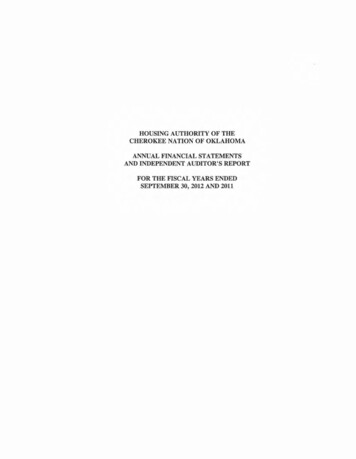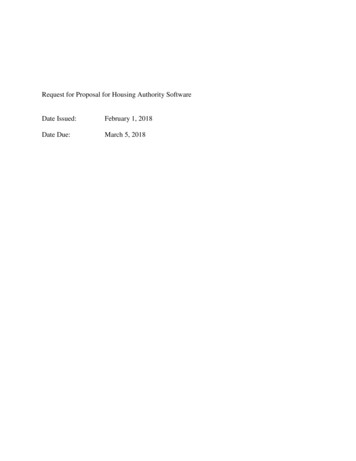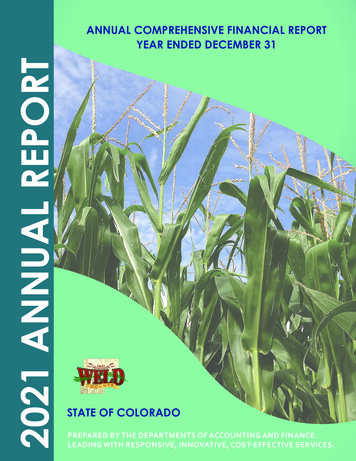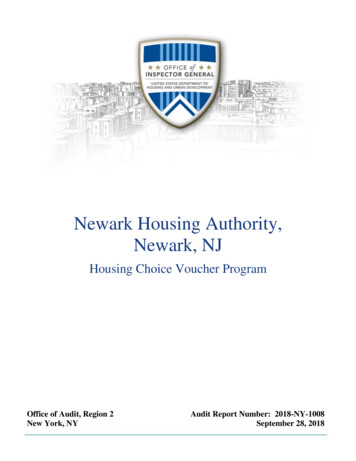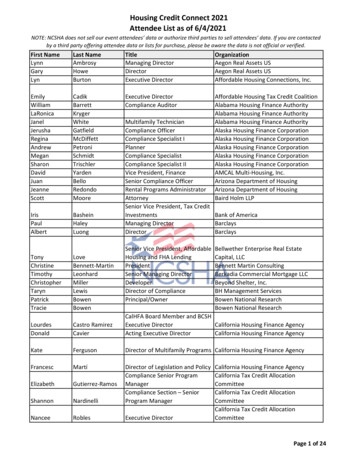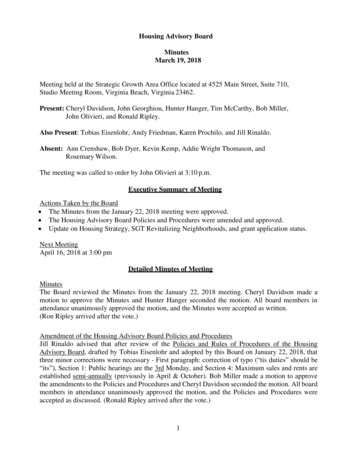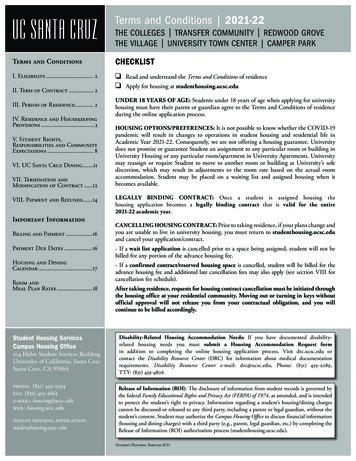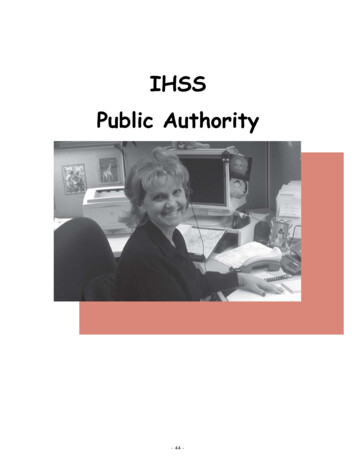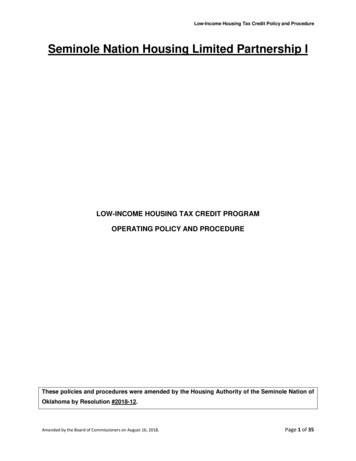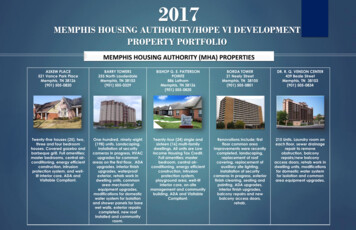
Transcription
Public Housing Authority Financial Management TrainingModule 13:Personnel Policies
Module 13 Topics Contracting Out Services PHA Employee Compensation– Items to Consider– Maintenance Wage Determination– Executive Compensation Limits Time and Attendance Policies– Fair Labor Standards Act (FLSA) – Exempt and Non-Exempt– Frequent Topics Employee Evaluations– PHA Bonuses PHA Hiring Policy and Practices
Module 13CONTRACTING OUTSERVICES
Contracting Out: Factors to Consider - Activity Is the activity temporary, recurs in cycles, or requires less than a full-timeresource?– Plumbing, Electrical, Information Technology (IT) Would it cost less for the PHA to outsource the activity? Would the quality ofthe work be better if outsourced?– Grass-cutting, snow removal, painting While the activity can be performed in-house, is staff time better usedelsewhere?– Payroll Does the activity require specialized knowledge and is it impractical to have aPHA employee perform this function?– Legal, Human Resources What can the PHA afford to pay?
Contracting Out: Factors to Consider –PHA Staff Assessment What are staff’s duties and workload?– Examine productivity metrics for staff Maintenance – Number of work orders completed; work order completiontime; average unit turnaround-time, etc. Property Management – reexaminations, unit inspections, lease-up time, etc. What are the skill set of staff? What is the contract cost versus contract benefits?
Contracting Out: Who to Contract To? Who to Contract To?––––Private companiesOther PHAsCityShared-service arrangements with other entities When contracting, PHA should consider:– Oversight of Contract– Contract Cost– Compliance with HUD regulations and PHA’s policies
PHA Services Typically Contracted OutAdministrative ServicesMaintenance Services Information Technology (IT) ServicesLegal ServicesAccountingPayroll/Human ResourcesProperty ManagementGrass-cutting/Snow Removal ServicesREAC InspectionUnit turnsPaintingCleaning servicesSpecialized (Plumbing, Electrical, Roofing, etc.)HQS Inspections (HCV Program)Note: PHAs with unionized workforce may be constrained when considering what services can be outsourced
Module 13PHA EMPLOYEECOMPENSATION
PHA Employee Compensation Items to Consider Why are salary reviews important:– Compliance with HUD requirements– Salary not competitive for market place; not able to attract and retain talent– Pay equity (Review to make sure that there is not a pattern of inequity between gender,race, or other State or Federal protected class) Has the PHA established a minimum (entry level), midpoint, and maximum salaryrange for each position?– Entry level pay is typically 75-80% of the market rate– Market rate what an experienced solid performing employee is paid– Highly experienced employee pay is typically 120% to 125% of market rate How does the PHA determine pay increases and bonuses? Who in the PHA is authorized to approve pay increase and bonuses?
Salary Comparability Review PHAs should periodically perform a salary comparability review for all PHApositions– Determine methodology and data source to be used– Review pay scales to make sure align with other staff positions (for example, amaintenance position generally should not be paid more than a propertymanager position Surveys of comparable wage data can be gathered from the followingsources:– Local area private entities that employ workers in similar positions (e.g.,apartment complexes, private management companies, etc.)– City Human Resources – If the PHA is connected with the City and complieswith the City’s personnel/human resource policy– Hire a firm to conduct salary survey
HUD’s Requirements for PHA Compensation Compensation for PHA staff is largely determined by a PHA’sBoard of Commissioners and Executive Director HUD’s requirements for PHA compensation only pertains to:– PHA Maintenance: PHAs are required to annually establish aprevailing wage (i.e., minimum hourly wage) for maintenancepositions– PHA Executives: Congress caps the amount that the Board can payPHA executive positions using certain HUD program funds
Prevailing Wage Requirements: Maintenance Maintenance work on properties under the Annual Contributions contract (ACC)are subject to prevailing wage requirements, that is the minimum hourly wage thatcan be paid for maintenance (Source: Section 12(a) of the US Housing Act of 1937) Prevailing wage requirement is set by each PHA and applies to:– Routine Maintenance: Janitorial and maintenance staff– Non-Routine Maintenance: Includes electrical, roofing, or other classification that areperformed annually by licensed contractors (HVAC, elevator, etc.)– Development (required under Davis-Bacon Act) HUD’s Davis Bacon and Labor Standards Office is responsible for theadministration and enforcement of labor standards within theirjurisdiction– There are regional and local field offices that work with all PHAs
PHA Maintenance Wage Determination PHAs are required to submit a maintenance wage determinationand fringe benefits (if applicable) to HUD annually– Applies whether work is performed in-house or maintenance is contracted The maintenance wage determination should represent:– Minimum or lowest hourly wage that a PHA is permitted to pay amaintenance position– Entry-level position and not an experienced or long-time employee Davis-Bacon wage can be used as a rough proxy for theprevailing maintenance wage determination
PHA Maintenance Wage Determination Process HUD sends the PHA a letter at least 180 days before the PHA’s fiscalyear start date. The letter requests that the PHA submits theproposed prevailing maintenance wage rate, and fringe benefits (ifapplicable), using:– HUD Form 4750 (Maintenance Wage Rate Recommendation);– Collective Bargaining Agreement; or– Survey of wage rates using HUD Form 4751 (Maintenance Wage RateSurvey) and 4752 (Maintenance Wage Rate Survey – Summary Sheet) Position descriptions must also be submitted, if HUD does not havethis information or if changes have been made
PHA Maintenance Wage Determination Process (continued) The wage information and position descriptions for each maintenanceclassification is due to HUD at least 90 days before the PHA’s fiscal year start date HUD approves maintenance wage determination 30 days before PHA’s fiscal yearstart date HUD’s Davis Bacon and Labor Standards office will issue the PHA a HUD Form52158 (Maintenance Wage Rate Decision). Form 52158 is the same as HUDForm 4750 submitted by PHA, with the approved wage rates for all maintenancework classification If the PHA does not submit the wage information to HUD, HUD will calculate theprevailing maintenance wage rate for the PHA using last year’s submitted data xConsumer Price Index (CPI) inflation rate. For 2016, the CPI was 0.5%
HUD 52158 Form - Example
PHA Maintenance Wage Determination –Other HUD Requirements Posting Requirements: HUD Form 52158 must be posted inemployee common area (lunch room, office, etc.) and incorporatedinto routine maintenance contracts Recordkeeping: PHAs must maintain records associated withdetermination of maintenance wage determination for 3 years HUD Resources: HUD Handbook – Federal Labor StandardsRequirements in Housing and Urban Development Programs(1344.1 REV 2 issued 2012)
PHA Executive Compensation: HUD Requirements Starting in FY 2012, Congress capped the salary, including bonuses, for theExecutive Director or any other PHA employee paid using Section 8 and 9 fundsto the annual rate of basic pay for Level IV of the federal Executive Schedule– Section 8 & 9 Funds include: 1) HCV; 2) Capital Fund; 3) Operating Fund; and 4) ROSS Does not apply to Moderate Rehabilitation or Project Based Rental Assistance (PBRA) funds– Salary cap does not apply to overtime and benefits (such as retirement, lifeinsurance, medical insurance, or the use of a PHA vehicle)– For 2018, the pay cap is 164,200 annually. Salary and bonus above this level, mustbe paid for with other funds Salary cap applies to all PHAs, including Moving-to-Work (MTW) PHAs
PHA Executive Compensation: HUD Requirements (continued) PHAs with a COCC: COCC fees from Section 8 & 9 funds that areused to pay PHA employees’ salaries are also subject to the salarycap If several PHAs hire the same person, the cap applies to thatperson’s total compensation from all sources Covered Individuals: Includes all PHA employees and persons whoare employed in a legally separate entity of the PHA but arereported in the PHA’s financial statement as a component unit– Not Covered: Independent contractors or hourly employees
PHA Executive Compensation: HUD Requirements (continued) PHAs are required to submit executive compensation information annuallyusing HUD-52725 form (Excel-based) and submit online through HUD’sSecure Systems– Salary information provided for: 1) top management official; 2) top financialofficial; and 3) highest compensated employee, not top management or financialfor full calendar year– Compensation is to be broken out by salary and bonus; and by funding source(Section 8 funds, Section 9 funds, and non-Section 8 or 9 funds)– Data Source: Compensation reported based on employee's W-2 form Penalty: HUD may impose monetary sanctions as well as other remediespursuant to HUD regulations for failure to comply with reportingrequirements
PHA Executive Compensation: HUD Requirements (continued) Executive Compensation data will be made available on HUD’s website Website for CY 2015 executive compensation data:– https://portal.hud.gov/hudportal/HUD?src /program offices/public indian housing/reac/rd/cy15phaec When reviewing, please note the following:– The 2015 compensation limit was 158,700. Salaries are further broken out into portionpaid with Section 8 & 9 funds and salary from non-Section 8 & 9 funds CEO Executive Director; CFO Finance Director; Executive Other (for example, MaintenanceSupervisor) Some salaries may appear artificially low and may indicate where an individual is serving as a parttime ED or an ED for multiple PHAs HUD provides annually a PIH Notice on how to report the ExecutiveCompensation information to HUD
Module 13TIME & ATTENDANCEPOLICIES
Fair Labor Standards Act Requirements FLSA Requirements: Initial law was enacted in 1938 and establishes minimumwage, overtime pay, recordkeeping, and child labor standards for full and parttime workers in the private and public (Federal, state, local) sectors– The Act generally applies to hourly employees– Minimum Wage: Requires that non-exempt employees be paid at least the federalminimum wage (currently 7.25 per hour) Where the state minimum wage rate is higher than the federal rate, employers are required to payworkers the higher amount.– Overtime: Requires that non-exempt employees be paid overtime (i.e., time and a half)for hours worked over 40 in a work week– Record-keeping: Employers are required to keep records on employees’ wages, hours,deductions, etc. as provided in the Department of Labor regulations PHAs need to define: 1) work week and 2) work-day Records do not have to be kept in any particular form and time clocks are not requiredto be used
Fair Labor Standards Act Requirements (Continued) Policies Not Covered by FLSA:–––––––Vacation;Holidays off or pay;Severance;Sick pay;Meals or rest periods;Pay raises or fringe benefits;Employee discharge Employees Exempted from FLSA: The following positions are generally exempt from FLSA’sminimum wage and overtime requirements – considered to be salaried employee––––ExecutiveProfessional CapacityCertain computer-related positionsIndependent contractors
Fair Labor Standards Act Exempt Employees All criteria must be met to be considered exempt from FLSAExempt Employees: Classification Criteria1. Hired to do a job – not for the quality or quantity of 5. Work is directly related to management orwork, or number of hours workedbusiness operations of employees or customers2. Must be paid a guaranteed salary or fee withoutregards to number of hours worked6. Can bind the employer in financial orcontractual matters3. Currently, must be paid not less than 455/week; 1,971.67/month (equivalent 23,660/annually)7. Executive: Must supervise at least 2 FTEs4. Primary duty – office (not including clerical duties)or non-manual work8. Exercises discretion and independentjudgement for significant matters
Exempt and Non-Exempt Classification PHA ExampleNon-Exempt PositionsExempt Positions HCV Staff Executive Director Maintenance Staff Senior Management Deputy Director Program Supervisor Finance Director Clerical Staff Property Managers & Assistant Managers Other Professional Staff Human Resources Legal Information Technology (IT) Procurement Modernization Coordinator Accountant
1. Time Reporting Non-Exempt EmployeesPHAs generally require Non-Exempt employees to clock in and out for payroll andattendance purposes to conform to FLSA requirements Hours Worked: Includes all time an employee must be on duty, on the employerpremises, or at any other prescribed places of work Travel Time: Travel from job site to job site during the workday must beconsidered as part of hours worked Rounding Hours Worked: A PHA can round an employee time to the nearestquarter hour (i.e., 15 minutes increments)– Employee time from 1 to 7 minutes may be rounded down and not counted as hoursworked– Employee time from 8 to 14 minutes must be rounded up and counted as a quarterhour of work time– Prohibited from always rounding down (29 CFR 785.48(b))
1. Time Reporting Non-Exempt EmployeesBest Practices Time Tracking for Non-Exempt Staff: Personnel Policy should include: How early/late employees can clock in or out for a shift. For example: no sooner than10 minutes before or no later than 10 minutes after a shift Whether Non-Exempt staff is required to clock in and out for lunch breaks or restperiods Prohibition on employee clocking in or out for another employee Overtime work requires prior authorization from supervisor Additional Time Tracking Policy for Maintenance Staff: If maintenance starts/ends dayat a unit, they should call property office and request that the property manager toclock the person in/out Time sheets are signed by employee and immediate supervisor Time & attendance records maintained by designated office, e.g., Finance
2. Time Reporting Exempt EmployeesFLSA does not require or prohibit that Exempt Employees time be tracked PHAs can require Exempt Employees to use a time clock in order to trackattendance– The PHA must implement this policy evenly. For example, the PHA Cannot require that one property with exempt employees use a time clock because ofproblems with attendance and tardiness but not require the same for another property. Cannot require exempt HCV employees but not exempt PH employees to use a time clock– PHAs cannot deduct pay from exempt employees for tardiness– PHAs can use time reporting data for disciplinary actions Best practice for exempt Public Housing property staff:– Post and maintain established office hours– Require visitor log at property office
3. On-Call Policy: Non-Exempt Employees FLSA Requirement (29 CFR 785.17):– An employee who is required to remain on call on the employer’s premises or close to the premises sothat the employee cannot use the time effectively for personal use is considered working while on call– An employee who is required to carry a cell phone, or a beeper, or who is allowed to leave a messagewhere he or she can be reached is not working (in most cases) while on call– Additional constraints on an employee’s freedom could require on call time to be compensated Option for PHA On-Call Policy:– Provide flat fee amount for person on call (Example: 50 a week)– Pay for hours actually worked– Provide a minimum number of hours to be paid if there is a work order call For example, the PHA’s policy is to pay a minimum of 3 hours if there is a call. Ed is on call and received 1emergency work order that night which took him 2 hours to complete including travel time. The PHAwould pay him as if he had worked 3 hours
4. Annual (Vacation) Policy: All Employees Annual (Vacation) Leave: Governed by state law; most states do not require employers toprovide employees with vacation benefits, either paid or unpaid– Typically, if an employer choose to provide such benefits, the employer must comply with theestablished policy or employment contract Best Practice - PHA Annual Leave Policy:– Establish a policy or provision that denies the payment of accrued annual leave upon separationfrom employment without two weeks notice.– Establish number of hours earned per pay period, annual leave cap, and cap on annual leavecarryover– Annual leave cannot be advanced to employees– Annual leave is not transferable between employees– PHA cannot buy back annual leave from employees
Frequent Topic:5. Sick Leave Policy: All Employees Sick Leave: Governed by state law; most states do not require employers to provideemployees with sick leave, either paid or unpaid PHAs will need to comply with the Family and Medical Leave Act Best Practice - PHA Sick Leave Policy:– Situations where sick leave should be taken (e.g., personal illness, care of employee’s spouse ordependent children, health care appointments, etc.)– Number of hours accrued per pay period and annually– Whether new employees or employees in a probationary period can earn sick leave– Whether employees on injury leave or in a non-pay status can accrue sick leave– Whether accrued sick leave is paid upon separation from employment– No advancement of sick leave is permitted Consider a consolidated or Paid Time-Off (PTO) plan versus traditional annualand sick leave plan
Module 13EMPLOYEEEVALUATIONS
Employee Evaluations: Factors to Consider PHA assumes significant risk when dismissing an employee (outside of probationaryperiod) when an employee evaluation has not been conducted in accordance with thePHA’s Personnel Policy Employee evaluation should align with position description and duties Establish timeline for conducting employee evaluations. Steps in the process include:– Goal-setting: At the beginning of the fiscal year, employee and supervisor should establishemployee’s goals (including training/professional development) for the year– Feedback: Provide feedback (formal or informal) and possible areas for improvementduring the year– Impact on Pay: Annual evaluation of employee’s job performance should be aligned withconsideration of merit pay increases Evaluations (both goals and outcomes) should include information on job metricswhere applicable
Employee Evaluations: Factors to Consider (continued) Typical components of employee evaluation:ComponentComponent1.Quality – The employee’s work is accurate, thorough,and neat.6.Independence – The employee performs work with little or nosupervision.2.Productivity – The employee produced a significantvolume of work efficiently in a specified period of time.7.Creativity/Initiative – The employee proposes ideas, seeks outassignments, and assumes additional duties when necessary.3.Job Knowledge – The employee possesses thepractical/technical knowledge required on the job.8.Adherence to Policy – The employee follows safety andconduct rules, other regulations and adheres to PHA policies.4.Reliability – The employee can be relied uponregarding task completion and follow-up.9.Collegiality – The employees communicates and cooperateswith coworkers, supervisors, subordinates, and /or outsidecontacts.5.Attendance – The employee is punctual, observesprescribed work break/meal periods and has anacceptable overall attendance record.10. Judgement – The employee demonstrates proper judgmentand decision-making skills when necessary.
Executive Director Evaluation Board Evaluation for Executive Director– Should be conducted annually– PHA metrics should be considered; metrics should be focused onwhat is in the control of the PHA– Should be conducted prior to renewal of Executive Director’s contract
PHA Bonuses OMB in 2 CFR 200.430(f) has the following guidance on bonusesIncentive compensation. Incentive compensation to employees based on cost reduction, orefficient performance, suggestion awards, safety awards, etc. is allowable to the extent that theoverall compensation is determined to be reasonable and such costs are paid or accruedpursuant to an agreement entered into in good faith between the non-Federal entity and theemployees before the services were rendered, or pursuant to an established plan followed by thenon-Federal entity so consistently as to imply, in effect, an agreement to make such payment. Applicability to PHA. A housing authority is considered a “non-Federal entity” so thisprovision applies to PHAs Justification for Bonus. Cost reduction, efficient performance, suggestions, safety awards
PHA Bonuses (continued) Agreement Required Before Services are Rendered. The amount of bonus and themetrics a person must meet in order to get a bonus must be established beforehandand not after the fact (e.g., goal-setting). PHA must ensure that the determinationthat a person meet the metrics was properly determined (e.g., staff evaluation)– Metric target should reflect “cost reduction” or “efficient performance” Christmas Bonus. Based on OMB’s requirement, Christmas/Holiday bonus is notpermitted Longevity Bonus. Does not appear to fit into the intent of the provision to lowercosts, improve efficiency, etc. Applicability to Executive Director Bonus. This provision only applies to ExecutiveDirectors that are hired as an employee (W-2) and not under a contractarrangement
Module 13PHA HIRING POLICYAND PRACTICES
PHA Hiring Policy – Why ImportantStatistic Workplace violence accounts for 18% of all violent crime (Workplace Violence: Bureau ofJustice Statistics) The typical organization loses 5% of its annual revenue to occupational fraud (Association ofCertified Fraud Examiners (ACFE): 2014 report on Occupational Fraud and Abuse) About 1/3 of resumes have some degree of puffery (Bankrate.com: Do a ThoroughBackground Check on Workers – Or Let the Hirer Beware) 16% of executive resumes contain false academic claims and/or material omissions relatingto educational experience (Business Week: Executives Making It by Faking It) The replacement cost of a bad hire is up to 3 times the salary of the job in question (Impactof a Bad Hire: Right Management Survey)
PHA Hiring Policy PHA should establish strong hiring policy to ensure that potential hires has thenecessary knowledge, experience, and skills. In addition, a PHA’s hiring policyshould ensure that a potential hire has integrity and is trustworthy Keys to an effective PHA hiring policy:–––––Use application form for systemic pre-screening of a potential hireConduct reference checksPerform background checksUse employment contract provisions that protect the PHATest candidates’ knowledge for certain skilled positions Interviews can be helpful but some prospective hires can present themselves well.Verified past behavior is considered the best indicator for future performanceSource: HUD Inspector General Bulletin (December 4, 2013)
Application Form Components Employment History––––––Timeframe of employmentJob titleJob dutiesSupervisor nameSalaryReason for leaving Education and degree(s) earned (including institution and date) Request reference checks Request information required for background check:– SSN, other names used, current and previous address (if less than 5 years) Disclosure of potential conflict of interest or nepotism
Application Form Components (continued) Include certifications that the applicants sign. For example:Certifications I certify that in the last 10 years, I have not committed a felony offense. I certify that in the last 10 years I have not filed for bankruptcy and am not currently more than 180 days delinquenton any financial obligation. I certify that neither my immediate family nor I have any conflicts of interest with housing authority business. I certify that all of my answers on this certification are true and complete. A provision permitting the PHA to contact references and to perform a background check A provision stating that deliberate failure or refusal to sign certifications is grounds fordenial of the position A provision stating that an applicant’s failure to provide complete and accurateinformation is grounds for denial of the position or termination
Application Review Review and verify information provided on application Look for potential Red Flags:–––––––Unexplained gaps in employmentLost licensesFrequent job changesTerminationsAdmissions of criminal behaviorPotential falsification or misrepresentation of information providedApplicant is willing to accept a significant pay cut
Reference Checks Compose questions for references in advance and document response toquestions Example of questions for reference checks:– Applicant duties at previous job– Reason for applicant leaving or wanting to leave his or her last position– Applicant’s work ethic, timeliness, professionalism, and ability to work well with others Potential Red Flags– Duties as described by reference is different or less meaningful than applicantrepresents– None of the references is from someone who is the applicant’s prior or currentsupervisor– Reference is marginally related/relevant to position considered for
Background Checks Background checks should be performed before a job offer is made The following checks should be performed:––––Criminal historyPrior employmentCredit reportInternet search to verify employment and position For position of trust hires (e.g., Executive Director, Finance Director, etc.),– Check with HUD– Check Departmental Enforcement Center (DEC) for information on limited denial ofparticipation, suspension or debarment– Office of Inspector General (OIG) audit reports– Internet searches of prospective employee or (former) place of employment
Employment Contract Provisions Employment contracts should not include the following:– Unreasonable bonuses– Buy-out clauses and unreasonable separation (severance) pay Employment contracts/personnel policies should have provisions that:– Require financial disclosures for position of trust as permitted by State law– Limits PHA liability for acts of fraud, financial non-compliance, personal tortclaims (harassment, hostility), etc.– (Personnel Policy) State that employment is at will (i.e., an employee can bedismissed by an employer for any reason (that is, without having to establish“just cause” for termination), and without warning State Civil Service Rules , union agreements etc. may limit at will employment
Test for Skilled Positions Where possible, PHAs should test or quiz candidates for certain skilled positions For example:– PHAs could test staff on word-processing and spreadsheet software such as MS Wordand MS Excel.– Maintenance candidates could be tested on maintenance skills (See HUD’s HousingManager’s Procedures Manual – PHA) Link:https://www.hud.gov/sites/documents/DOC 9211.PDFExample Questions:1. What type of drywall sheeting is best suited foruse in interior, high moisture areas?a. Bulldog wet boardb. Brown boardc. Green boardd. Primer grade yellow board2. Which of the following items would not beused to repair a wooden door?a. Drywall compoundb. Plastic woodc. Rubbing compoundd. Carpenters glue
End of ModuleThis Ends the Training Module onPersonnel Policies
- Salary cap does not apply to overtime and benefits (such as retirement, life insurance, medical insurance, or the use of a PHA vehicle) - For 2018, the pay cap is 164,200 annually. Salary and bonus above this level, must be paid for with other funds Salary cap applies to all PHAs, including Moving-to-Work (MTW) PHAs
